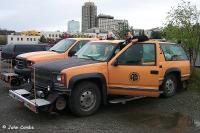 |
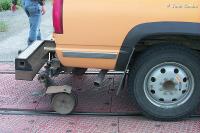 |
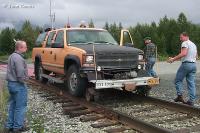 |
| Frank Dewey and Hi-rail 1100 | Mounting the Hi-rail at Portage | "Looks good. Let's go!" |
Five hours of sleep was not nearly enough, but the adrenaline rush kicked in when the alarm sounded at 7:00 a.m. A hot shower and breakfast helped to prop my eyelids open the rest of the way.
I was excited because today was "Loop District" day. Let me give you a little background information before I go on. In 1908 the Alaska Railroad constructed a loop between mileposts 47.5 and 50.8 to combat a steep section of terrain and thus lessen the grade. It proved to be an incredible engineering feat of its day and remained in use until 1951. While on a rail trip to Seward during my Alaska Railroad 2000 trip, a railroad employee pointed out some remains of the old loop. Now I'm the kind of guy who gets really fascinated by remnants and remains of old structures. It is kind of like a visit to the "land of the lost" which emanates an overall eerieness of a ghost town. There is a certain amount of mystery and excitement for me. So the employee's bird dogging of these loop remains really piqued my curiosity. I asked him how accessible this area was and he replied that no roads existed into the area and it was a 20 mile hike round trip. Even then I knew I had to figure out a way to get back to this area.
When I knew I was taking this trip, I began making inquiries to the railroad for gaining access to the old Loop District. My friend Don Prince asked Terminal Superintendent Curt Rudd if something could be arranged. As it turned out, some safety employees would be taking a Hi-rail vehicle through that area on July 25 as part of a safety audit and I would be welcome to ride along. They would stop at various "loop remnant" locations so I could snap a few photographs. I asked locomotive engineer and friend Frank Dewey if he would accompany me on this trip. He agreed and submitted a request to take that day off.
Back to the present. I stopped by Josh Coran's (ARR Chief Mechanic) office at 8:20 a.m. and picked up a chart showing the old and new routes that ran through the Loop District. This would assist me in locating the old grade.
I met Curt Rudd at his office at 8:30 a.m. Curt has the personality like that of a long lost friend. He is happy to see you. He wants to know how you've been, what you've been up to, how the wife and kids are and most importantly what he can do for you. This conversation is punctuated by numerous interruptions of phone calls. Curt handles these with the efficiency of a multi tasking super computer. As each new phone call comes in, he puts the current one on hold. These calls can get stacked as much as three deep. He then works his way back down each call, picking up the conversation exactly where he left off. These phone calls are interrupted with numerous "I'm just gonna stick my head in for a minute" and "what should we do now" office visitors. Where as my stress level would eat me alive in this environment, Curt seems to thrive on it. And I must admit the visit was a railfan's delight since I got an up close and personal view of day-to-day railroad operations.
Just as things seemed to calm down for Curt, Steve from the Federal Railroad Administration came through the door. The FRA's purpose is to ensure a safe, efficient and effective passenger and freight railroad network. Steve spent about twenty minutes firing dozen of questions at Curt to determine if railroad procedures were up to par. From my viewpoint it looked like Curt scored a birdie.
Finally, it was time to begin the Hi-rail adventure.
Frank Dewey, Paul Gangstad, two new railroad employees and myself hopped
into Hi-rail 1100 in front of the Anchorage Depot. Paul drove us
down scenic Turnagain Arm to Portage where he was granted track warrant
access to place the Hi-rail onto the tracks. Paul taught the new
employees how to mount the vehicle's Hi-rail gear to the track and off
we went. Hi-rail travel is somewhat noisy and fairly bumpy, but as
Paul pointed out, not nearly as bad as the old gas
powered MOW cars which had no shock absorbers, left you somewhat exposed
to the elements and had no heat or air conditioning.
 |
 |
 |
| Frank Dewey and Hi-rail 1100 | Mounting the Hi-rail at Portage | "Looks good. Let's go!" |
The snow shed at milepost 51 was our first stop. Frank and I walked down the track embankment and entered the brush heading in the general direction of the snow shed. Now I've done a fair amount of bushwhacking in my time, but the alder bushes I encountered were very nasty. Branches from one bush entertwined with the next to create a nearly impenetrable wall of brush. The best way to beat this was to crawl under it. This technique definitely gave our anti-perspirant a run for its money. We crossed a small snow field and then hoofed it part way up the side of the mountain. As one might guess, the snow shed was flattened into a bizillion shattered pieces. Frank was astute enough to find several old railroad ties and was able to retrieve a spike from one which he gave to me. Later I asked several veteran railroad employees to determine the age of the spike and they said it may very well be an original one.
For beginners only: A snow
shed is a timber portal built to help keep the tracks clear in areas of
high avalanche hazard. If an avalanche occurs, the debris (snow,
mud, rocks, etc.) runs over the top of the shed keeping the tracks clear
and allowing the train to continue on its way.
 |
 |
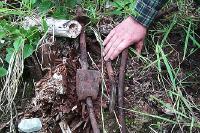 |
| Begin Slide Zone 53 | Remnants of old snow shed | Snow shed bolt and railroad tie spike |
We retraced our steps and returned to the Hi-rail vehicle panting like a bunch of old goats and swatting mosquitoes. Paul then drove us through five short tunnels which all occurred in the span of less than a mile. One of the tunnels contained a sheet of plywood with car hub caps mounted to it. Strange, but true. As we emerged from the last tunnel, Frank pointed out the spot where the helicopter crashed during the filming of the movie Runaway Train. We made a quick stop at the Tunnel section house where the track section workers for this area live. This two-story section house contained a TV/VCR with movies, exercise machines, kitchens, bedrooms and bathrooms. Paul had worked here several winters and informed me a ghost lived in the section house. "In the middle of the night it would turn on the lights, open and shut doors and turn on the TV."
For Alaska Railroad addicts only:
Tunnel section house is made up of the original basement of the old Tunnel
section house and the then newly replaced Carlo and Broad Pass sections.
Both Broad Pass and Carlo had had their original houses replaced with modular
houses only 5-7 years before. Carlo is the first floor and Broad
Pass is the second. You will notice that the south end of the house is
cantilevered over the basement because the newer houses were much larger
than the older ones.
 |
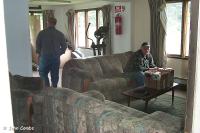 |
| Tunnel section house | Frank sitting in the house's living room |
Around the outside of the section house was a cadre of odds and ends, the most interesting of which is a 105 mm recoilless rifle storage unit. Before the snow accumulates into an unmanageable menace, workers fire a round at an overhang or drift and knock it down. Paul said China was the only country left selling ammunition for this rifle and that is was getting more and more expensive each year.
Back in our trusty Hi-rail, we continued on to the old
"Loop District." Paul stopped frequently so I could snap photographs
of the old bridge abutments, wooden trestle posts and old grade.
The most fascinating sight was a trail of shorter brush which traced out
the actual location of the loop itself. Little did I know that later
in the trip I would get an even better view of this.
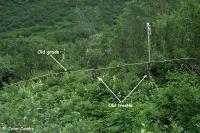 |
 |
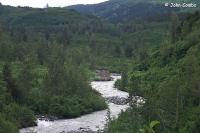 |
| Old grade and parts of the old trestle | Close up an old trestle support | Concrete piling trestle support |
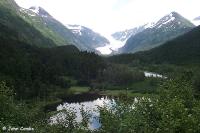 As
we left the Loop District, Frank and Paul began pointing out various "insider"
points of interest. Paul pointed out a spot in the river where several
section workers panned for gold during their off hours. They actually
found some, but apparently it wasn't much since they've kept their day
jobs. Then there was Bob's Rock where Bob hit a large boulder while
plowing snow with a Jordan
spreader. This caused the spreader to derail. These folksy stories
continued until we arrived at
Grandview.
Since there was no pad to turn the Hi-rail around, Paul put it in reverse
and headed back to Tunnel.
As
we left the Loop District, Frank and Paul began pointing out various "insider"
points of interest. Paul pointed out a spot in the river where several
section workers panned for gold during their off hours. They actually
found some, but apparently it wasn't much since they've kept their day
jobs. Then there was Bob's Rock where Bob hit a large boulder while
plowing snow with a Jordan
spreader. This caused the spreader to derail. These folksy stories
continued until we arrived at
Grandview.
Since there was no pad to turn the Hi-rail around, Paul put it in reverse
and headed back to Tunnel.
 I
was already getting a little sluggish by the time we returned to the yard
office at 5:00 p.m. Frank and I made a quick trip through the headquarters
building and then got into his Land Rover to explore more Alaska Railroad
stuff. We stopped by the airport to photograph the new rail terminal.
We also checked out a new section of double track, retired caboose 1075
being used as an office at Alaska Auto Auction and various surplused railroad
equipment at Alaska Metal Recycling.
I
was already getting a little sluggish by the time we returned to the yard
office at 5:00 p.m. Frank and I made a quick trip through the headquarters
building and then got into his Land Rover to explore more Alaska Railroad
stuff. We stopped by the airport to photograph the new rail terminal.
We also checked out a new section of double track, retired caboose 1075
being used as an office at Alaska Auto Auction and various surplused railroad
equipment at Alaska Metal Recycling.
We ate dinner at O'Brady's and I ordered a hamburger with an order of bottomless French fries. I have never seen bottomless French fries in my life and couldn't figure out how they were different from other ones I've had in the past. It was here that I realized I'd left my snow shed railroad spike in the Hi-rail. Since that vehicle was now locked and we no longer had the keys, there would be no way for me to retrieve the spike until morning. I worried out loud about that spike for the rest of the evening.
We spent the remaining part of the day playing in a giant
sand box. Frank pulled into Anchorage Sand & Gravel's pit in
Palmer and gave me the VIP tour. Frank had spent years running
gravel trains and was definitely in his element here. An empty
gravel train had just arrived so I would get a "hands on" view of the operations.
The photographs below tell the story:
The twenty one year old engineer on the gravel train had never loaded gravel before. Frank, the veteran gravel guy, hopped on board the locomotive and gave him a little on the job training. We continued to tour the facilities and take photographs. [I took six photos panning across the gravel facility from atop the conveyor to produce this 3470x450 177K composite panoramic image.] Frank also did a little four wheeling through the gravel pit area in his Land Rover.
At 11:00 p.m. we left the gravel pit and headed for home.
My brain felt like over cooked spaghetti. Frank talked all the way
back to the yard office, but at times my brain wasn't receiving all the
information. Several times I asked myself, "What is it he just said?"
I returned to Don's condo as the clock struck midnight and immediately
fell into bed. A 17 hour day!